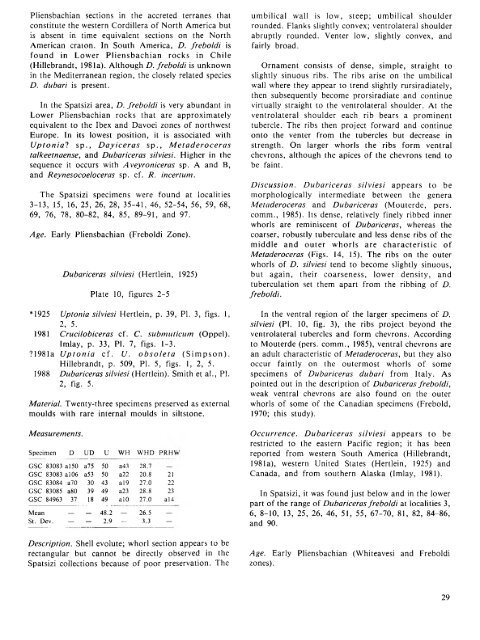PLIENSBACHIAN (LOWER JURASSIC) BIOSTRATIGRAPHY AND ...
PLIENSBACHIAN (LOWER JURASSIC) BIOSTRATIGRAPHY AND ...
PLIENSBACHIAN (LOWER JURASSIC) BIOSTRATIGRAPHY AND ...
You also want an ePaper? Increase the reach of your titles
YUMPU automatically turns print PDFs into web optimized ePapers that Google loves.
Pliensbachian sections in the accreted terranes that<br />
constitute the western Cordillera of North America but<br />
is absent in time equivalent sections on the North<br />
American craton. In South America, D. freb o id i is<br />
found in Lower Pliensbachian rocks in Chile<br />
(Hillebrandt, 1981a). Although D. freboldi is unknown<br />
in the Mediterranean region, the closely related species<br />
D. dubari is present.<br />
In the Spatsizi area, D. freb o ld i is very abundant in<br />
Lower Pliensbachian rocks that are approximately<br />
equivalent to the Ibex and Davoei zones of northwest<br />
Europe. In its lowest position, it is associated with<br />
U p to n ia ? sp., D a y ic e r a s sp., M e ta d e r o c e r a s<br />
talkeetnaense, and Dubariceras silviesi. Higher in the<br />
sequence it occurs with Aveyroniceras sp. A and B,<br />
and Reynesocoeloceras sp. cf. R. incertum.<br />
The Spatsizi specimens were found at localities<br />
3-13, 15, 16, 25, 26, 28, 35-41, 46, 52-54, 56, 59, 68,<br />
69, 76, 78, 80-82, 84, 85, 89-91, and 97.<br />
A ge. Early Pliensbachian (Freboldi Zone).<br />
Dubariceras silviesi (Hertlein, 1925)<br />
Plate 10, figures 2-5<br />
*1925 Uptonia silviesi Hertlein, p. 39, PI. 3, figs. 1,<br />
2, 5.<br />
1981 Crucilobiceras cf. C. subm uticum (Oppel).<br />
Imlay, p. 33, PI. 7, figs. 1-3.<br />
? 1981 a U p to n ia cf. U. o b s o le ta (S im p so n ).<br />
Hillebrandt, p. 509, PI. 5, figs. 1, 2, 5.<br />
1988 Dubariceras silviesi (Hertlein). Smith et al., PI.<br />
2, fig. 5.<br />
Material. Twenty-three specimens preserved as external<br />
moulds with rare internal moulds in siltstone.<br />
M easurements.<br />
Specimen D UD U WH W H D PRHV<br />
GSC 83083 al50 a75 50 a43 28.7 —<br />
GSC 83083 al06 a53 50 a22 20.8 21<br />
GSC 83084 a70 30 43 al9 27.0 22<br />
GSC 83085 a80 39 49 a23 28.8 23<br />
G SC 84963 37 18 49 alO 27.0 al4<br />
Mean — — 48.2 — 26.5 —<br />
St. Dev. — — 2.9 — 3.3 —<br />
D escription. Shell evolute; whorl section appears to be<br />
rectangular but cannot be directly observed in the<br />
Spatsizi collections because of poor preservation. The<br />
umbilical wall is low, steep; umbilical shoulder<br />
rounded. Flanks slightly convex; ventrolateral shoulder<br />
abruptly rounded. Venter low, slightly convex, and<br />
fairly broad.<br />
Ornament consists of dense, simple, straight to<br />
slightly sinuous ribs. The ribs arise on the umbilical<br />
wall where they appear to trend slightly rursiradiately,<br />
then subsequently become prorsiradiate and continue<br />
virtually straight to the ventrolateral shoulder. At the<br />
ventrolateral shoulder each rib bears a prominent<br />
tubercle. The ribs then project forward and continue<br />
onto the venter from the tubercles but decrease in<br />
strength. On larger whorls the ribs form ventral<br />
chevrons, although the apices of the chevrons tend to<br />
be faint.<br />
D isc u ssio n . D u b a ricera s silv ie si appears to be<br />
morphologically intermediate between the genera<br />
M etaderoceras and D ubariceras (Mouterde, pers.<br />
comm., 1985). Its dense, relatively finely ribbed inner<br />
whorls are reminiscent of Dubariceras, whereas the<br />
coarser, robustly tuberculate and less dense ribs of the<br />
middle and outer whorls are characteristic of<br />
M etaderoceras (Figs. 14, 15). The ribs on the outer<br />
whorls of D. silviesi tend to become slightly sinuous,<br />
but again, their coarseness, lower density, and<br />
tuberculation set them apart from the ribbing of D.<br />
freboldi.<br />
In the ventral region of the larger specimens of D.<br />
silviesi (PI. 10, fig. 3), the ribs project beyond the<br />
ventrolateral tubercles and form chevrons. According<br />
to Mouterde (pers. comm., 1985), ventral chevrons are<br />
an adult characteristic of Metaderoceras, but they also<br />
occur faintly on the outermost whorls of some<br />
specimens of D ubariceras dubari from Italy. As<br />
pointed out in the description of Dubariceras freboldi,<br />
weak ventral chevrons are also found on the outer<br />
whorls of some of the Canadian specimens (Frebold,<br />
1970; this study).<br />
O ccurrence. D u b a ricera s silv ie si appears to be<br />
restricted to the eastern Pacific region; it has been<br />
reported from western South America (Hillebrandt,<br />
1981a), western United States (Hertlein, 1925) and<br />
Canada, and from southern Alaska (Imlay, 1981).<br />
In Spatsizi, it was found just below and in the lower<br />
part of the range of Dubariceras freboldi at localities 3,<br />
6, 8-10, 13, 25, 26, 46, 51, 55, 67-70, 81, 82, 84-86,<br />
and 90.<br />
Age. Early Pliensbachian (Whiteavesi and Freboldi<br />
zones).

















